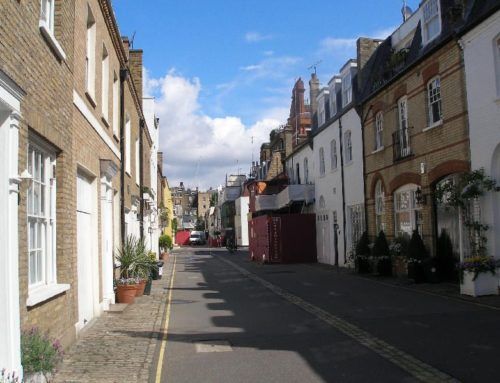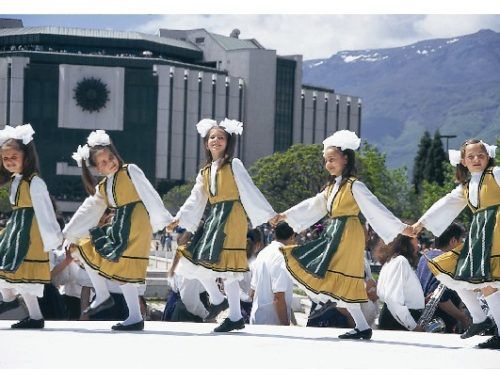Of Cabbages and Emperors
After twenty-one stressful years as Roman emperor, Diocletian retired to the peaceful gardens of his hometown of Split, Croatia to grow cabbages.

A view of the southern facade of Diocletian’s palace from the Adriatic, Split, Croatia.
A view of the southern facade of Diocletian’s palace from the Adriatic, Split, Croatia.
From the palace walls, Diocletian watched his garden in Salonae, where what he cultivated with his own hands gave him more satisfaction than when he ruled his huge empire. When Maximinus’ ambassador begged Diocletian to become emperor for a second time, he answered, “If you could show the cabbage I planted with my own hands to your emperor, he definitely wouldn’t dare suggest I replace the peace and happiness of this place with the storms of a never-satisfied greed.” H. Stieglitz, 1845
When Stieglitz, a German scholar, wrote these words after his travels in Istria and Dalmatia, two provinces of modern-day Croatia, he was probably paraphrasing Eutropius, a Roman scholar who lived in the second half of the fourth century. Stieglitz and Eutropius may have somewhat romanticized the situation, but their words capture the spirit of Diocletian’s love for cabbages.
Historians believe that Diocletian, Roman emperor from A.D. 284 to 305, returned to the Dalmatian coast when he retired in order, at least in part, to grow them. Domesticated brassicas were a staple in patrician cuisine, and when he returned to the area now known as Split, he brought with him knowledge of Roman foodways. It is also speculated that he considered cabbages especially healthy fare. (Today we know that cabbage is a natural healer of the stomach and intestines.)
Diocletian, born Diocles, was the son of an emancipated slave. Having little or no formal education, he gained his status from soldiering in an age of wars and eventually worked his way up through the ranks to become emperor. When he began to think about retiring, he built a behemoth palace in Split, just a few miles from his birthplace in Salonae (Solin). It took ten years (a.d. 295–305) to complete the palace, which resembled a military fort. Once it was finished, he started working his gardens in Salonae. In Diocletian’s time, it was a city of sixty thousand inhabitants and the largest Roman town on the Balkan peninsula.
It’s hard to know exactly what kind of cabbages he grew, but Romans did not know head cabbage. The original Mediterranean wild cabbages resembled modern-day loose-leafed kale. Peasant farmers eventually produced cabbages with leaves that curled in on themselves to form a head. Both white and red head cabbages were familiar by the twelfth century, as recorded by Saint Hildegard of Bingen.
The Croatian word kupus, probably originating from the Latin caput, is used in several ways but usually refers to a head, or head cabbage. The Latin word verzot might refer to curly cabbage, or what we call kale, and cyma to savoy cabbage. Cabbage seems to be universally popular and infinitely varied in Croatia. On a previous trip to Korcula–one of Croatia’s wine islands–I first saw a “stick cabbage” whose tobacco-sized leaves grew at the end of a foot-long vertical stalk and were not tightly compacted into a head.
When I visited Split last September, the farmers market sold several kinds of cabbage, kale, brussels sprouts, broccoli, and fresh sauerkraut–which jovial ladies fished out from huge barrels by hand. I was told that the fertile fields along the Cetina River in nearby Sinj were famous for growing brassicas during Roman times. Seventeen hundred years later, locals still ask for and value Cetina cabbages.
The oldest part of Split lies inside the ancient palace walls and has been designated a UNESCO world heritage site. It’s unique in that citizens have the right to live within the palace walls, making it the only inhabited Roman ruin. (It is not uncommon to see laundry artistically draped in open windows.) The palace was deserted from the time of Diocletian’s death in 313 until Julius Nepos came to Split after the Roman Empire collapsed. In the seventh century, nearby Salonae was destroyed by Avars and Slavs. Around this time ordinary citizens started occupying the palace, building homes in the existing spaces their descendants still occupy today.
In medieval times, some palace stones were stolen for other buildings. By the eighteenth century, some palace inhabitants had moved outside the protective walls and were renting their apartments to richer families, a pattern that continues today with some families selling their street-level apartments to make space for new businesses. The result of all the clamoring for space makes the core of Split a pleasing hodgepodge: Retrofitted apartments and businesses are squeezed into former barracks of Diocletian’s soldiers and above the emperor’s first-floor living
quarters, which overlooked the sea. Coffee shops–the mainstay of social life–are crowded, especially on the seaside esplanade along the palace’s southern facade. Unfortunately, there are no hotels or bed-and-breakfasts within the palace walls.
The palace’s remarkable preservation is most likely due to centuries of habitation. When the city fathers started to resto

re Diocletian’s residence, they had to dig through and examine tons of petrified garbage–which turned out to be an archaeological treasure trove. For generations, if not centuries, residents had dumped the garbage from their apartments above Diocletian’s abandoned quarters into the palace’s cellars. Today, the cellars are slowly being excavated and transformed into an underground museum that shares space with vendors.
If you tour the museum, you will see a huge, two-colored marble mensa, used in Diocletian’s time as a communal table. Tests show that the marble is not from the nearby Croatian island of Brac, source of the marble used for the White House. It may have come from Nicomedia, on the coast of Turkey, where Diocletian once centered his administration. Professor Igor Fiskovich, head of the medieval art department at the University of Zagreb, says the table’s excellent condition attests that it was used by the royal court.
A Stroke of Luck
I traveled to Split to research cabbage recipes and found it ever welcoming. Its mixture of limestone streets and ancient ruins juxtaposed against modern stores was intriguing. The residents speak a lilting and mellifluous Croatian that sounds almost like Italian. These linguistic tendencies are no surprise if you take history into consideration–this port town was once the flourishing Venetian city of Spalato. (Fiskovich told me that one popular theory is that Spalato got its name from aspalathos, the Greek name of an indigenous species of acanthus, a plant whose distinctive leaf shape is used as a decorative motif on Corinthian columns.)
By a great stroke of luck, the day before I arrived the local paper had run an article about five school friends, now in their fifties, who had written a cookbook about Diocletian entitled What Split’s First Inhabitants Ate. I hunted down one of the authors–Milorad Kresic–and spent an evening talking about history and food. Luckily he was willing to part with a cookbook–one of only seventy-seven copies.
The next morning, Ante Duplancic, an articulate, self-appointed palace historian, called to ask if he could interview me for the local paper. I thought this curious (the interviewer being interviewed!) but agreed to meet him at the Luxor Caf? Located in the peristyle across from Diocletian’s mausoleum, it was my favorite meeting place. Although the café doesn’t serve American-style coffee, the atmosphere created by the surrounding architecture–which includes an Egyptian black granite sphinx–offsets this disappointment. And if you sit under one of the tabletop umbrellas long enough, you will see the world pass by as camera-laden German and American tourists mingle with the locals and returning expatriates.
After our chat, Duplancic offered me a “culinary” tour of Diocletian’s quarters. From the mausoleum, it was just a two-minute walk to what had been the center of imperial life during Diocletian’s time: the emperor’s dining hall, called the Triclinium. Now it’s just an open space in the sun, though you can still make out the cruciform arrangement of chambers around the central hall. Without a guide you wouldn’t know you were standing where Diocletian dined. Nor would you notice the kitchens nearby–the only clue being the vestiges of great ovens now spray-painted with graffiti. Despite their fallen state (UNESCO offers no money for restoration, just doles out the coveted designation), it wasn’t too hard to imagine Diocletian and his entourage enjoying a raucous meal here.
Knocking on Doors
Historians believe that Diocletian always entered the city through the Golden Gate at the north and walked south to his residence along Cardo Street. (Cardo as the main north-south street and Decumanus as the main east-west street was a common configuration of Roman military architecture.) So I persuaded Duplancic to be my interpreter as I knocked on some doors just off Cardo and the main square.
One address we visited was the home of the Grisogono family, who had resided in the same spot at the corner of the main square since 1404. Unfortunately, when it came to cabbage, the lady of the house didn’t do more than boil it and occasionally make a raw salad. Combined with some visits a few nights before, my recipe hunt yielded no outstanding historical recipes in daily use save one–a dish called Arambasich–a traditional regional dish made by wrapping spiced meat in cabbage leaves.
Luckily, Kresic and his colleagues made my search easier: They had spent several years codifying and testing recipes for their book, no doubt drawing from Apicius de re Coquinaria, the most ancient of European cookbooks. Many of the recipes include exotic ingredients such as garum, a Roman condiment made from fermented mackerel intestines. Fortunately, a perfect substitute is Vietnamese fish sauce, which is also made from fermented fish guts. But go easy, this stuff is strong and smelly. A little too much will overpower all other tastes. Worchestershire sauce can also be used as a substitute for garum, but I think less perfectly.
Before I left Split and Diocletian’s palace, I walked north along Cardo Street to the Golden Gate and journeyed outside the palace walls on a mandatory pilgrimage. A huge statue of a Croatian saint by famed sculptor Ivan Mestrovic dominates the scene. Passersby stop to touch the saint’s golden toe in hopes of engendering good luck. I did the same and asked for good health, which I plan to encourage by ingesting ample quantities of cabbage.
Diocletian’s Boiled Cabbage
No one is exactly sure how Diocletian’s kitchen prepared cabbage, but it was most likely cooked in a traditional patrician way with good olive oil, garum (a Roman fish condiment), wine, and spices. Some of the spices in this recipe are a bit esoteric for American larders. Lovage is a perennial herb in the carrot family that is familiar to the English; Germans know it as Liebstockel, and the Romans called it ligusticum. Rue is a strong-scented woody perennial whose bitter leaves are used in medicine. You can find it with medical herbs at a good health food store, but one
might be tempted to leave it out.
- 1 bunch kale, or, if you prefer,
- 1 head green cabbage
- 1 tsp. ground cumin
- 1/4 tsp. ground black pepper
- 2 tsp. lovage
- 1 tsp. mint (your choice)
- 1 tsp. rue
- 1/2 tsp. ground coriander
- 3/4–1 cup white wine
- 3 Tbsp. olive oil
- 2 Tbsp. Vietnamese fish sauce”
Chop the kale into bite-sized pieces and boil in salty water until just soft (not overdone); drain well and then season with the spices, wine, olive oil, and fish sauce. Simmer for five minutes to combine the flavors.
Kale With Leeks
I choose a dark kale for this dish, so when mixed with the leeks the color contrast makes a very handsome dish. Lacinato is a dark green heirloom kale from Tuscany. Its blistery leaves have given rise to innovative names like “dinosaur” kale, but the Italians simply call it cavolo lacinato, or curly kale. It is sweet and delicious and so hardy it can be harvested under a foot of snow.
- 1 bunch Lacinato kale
- 2 leeks
- 2 Tbsp. olive oil
- 3/4–1 cup white wine
- 2–3 Tbsp. oil to fry leeks
- 3 Tbsp. Vietnamese fish sauce
- 1 tsp. ground cumin
- 1 tsp. ground coriander
- salt as desired
Chop kale into 1 1/2-inch pieces and steam or boil until soft. Drain and put in a bowl with the olive oil and half the wine. Set aside. Using the whole leek (both white and green parts), cut stalks in half lengthwise and wash very well. Slice again lengthwise and then cut into 1-inch pieces. Fry leeks in oil until just soft; add fish sauce, spices, and salt to taste. Serve as a side dish.
Arambasich
Stuffed Sauerkraut Rolls
This dish is a regional favorite from Sinj, a town thirty miles northeast of Split situated on the Cetina River. Its fertile fields produce wonderful cabbage. In Croatia, this recipe calls for full heads of sauerkraut or a whole pickled cabbage, but this is impractical for most kitchens, so I suggest steaming a whole head of cabbage as a substitute. I’ve punched up the flavor of the stuffing a bit by adding paprika.
- 1 head cabbage
- 1/4 lb. smoked bacon
- 1 medium onion, chopped
- 1 1/2 lbs. ground beef
- 3/4 lb. ground pork
- 3–4 garlic cloves, crushed
- 1/8 tsp. nutmeg
- 1/4 tsp. cinnamon
- 2 cloves, crushed
- 1 Tbsp. paprika
- 1/2 tsp. black pepper
- 1 tsp. salt, or to taste
- 1 egg
- 1 Tbsp. lard or oil
Finely dice the bacon and fry in a medium frying pan; add the chopped onion and continue frying until it’s translucent. Add the ground beef and pork, brown for about five minutes but not until completely done; let cool slightly. Add the garlic, spices, and egg. Stir to moisten.
Steam a whole head of cabbage to soften the leaves. Pull the leaves off the head one by one, carving some thickness off the central stems. Place a spoonful of the meat mixture in the center of each leaf and roll it up, beginning from the stem. As you do, tuck in the sides to secure the meat. Put lard or oil in the bottom of a large saucepan and cover with a few whole cabbage leaves. Arrange the rolls, seam side down, on top of the leaves. If desired, weigh the rolls down with a plate. Pour in enough water to cover the rolls, cover the pan, and simmer over low heat for about three hours.
Additional Reading:
Ivanka Bilus et al., Croatia at Table: The Aromas and Tastes of Croatian Cuisine, Alfa, Zagreb, 1997.
Milorad Kresic et al., Sto Su Jeli Privi Splicani (What Split’s First Inhabitants Ate), Split, 1999.
Mark Grant, Roman Cookery: Ancient Recipes for Modern Kitchens, Serif, New York, 1999.
Joseph Dommers Vehling, trans., Apicius: Cookery and Dining in Imperial Rome, Dover, New York, 1977.
Stephen Williams, Diocletian and the Roman Recovery, Routledge, New York, 1997.
Clifford Wright, A Mediterranean Feast, William Morrow and Co., New York, 1999.




Leave A Comment